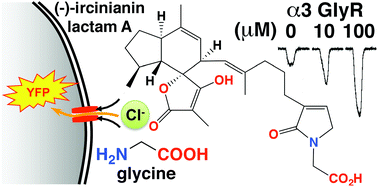Sesterterpene glycinyl-lactams: a new class of glycine receptor modulator from Australian marine sponges of the genus Psammocinia†
Abstract
Bioassay guided

* Corresponding authors
a
Institute for Molecular Bioscience, The University of Queensland, St. Lucia, QLD, Australia
E-mail:
r.capon@uq.edu.au
Fax: +61-7-3346-2090
Tel: +61-7-3346-2979
b
Queensland Brain Institute, The University of Queensland, St. Lucia, QLD, Australia
E-mail:
j.lynch@uq.edu.au
Fax: +61-7-3346-6301
Tel: +61-7-3346-6375
c Institute of Medical Biotechnology, Department of Chemical and Biological Engineering, Friedrich-Alexander University Nuremberg-Erlangen, Germany
d School of Biomedical Sciences, The University of Queensland, St. Lucia, QLD, Australia
Bioassay guided

 Please wait while we load your content...
Something went wrong. Try again?
Please wait while we load your content...
Something went wrong. Try again?
W. Balansa, R. Islam, F. Fontaine, A. M. Piggott, H. Zhang, X. Xiao, T. I. Webb, D. F. Gilbert, J. W. Lynch and R. J. Capon, Org. Biomol. Chem., 2013, 11, 4695 DOI: 10.1039/C3OB40861B
To request permission to reproduce material from this article, please go to the Copyright Clearance Center request page.
If you are an author contributing to an RSC publication, you do not need to request permission provided correct acknowledgement is given.
If you are the author of this article, you do not need to request permission to reproduce figures and diagrams provided correct acknowledgement is given. If you want to reproduce the whole article in a third-party publication (excluding your thesis/dissertation for which permission is not required) please go to the Copyright Clearance Center request page.
Read more about how to correctly acknowledge RSC content.
 Fetching data from CrossRef.
Fetching data from CrossRef.
This may take some time to load.
Loading related content
